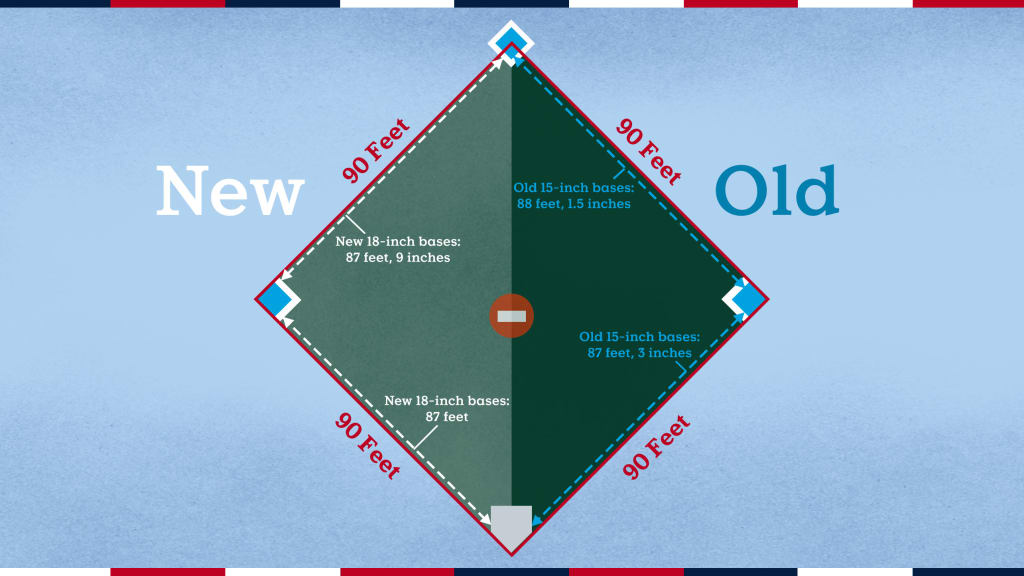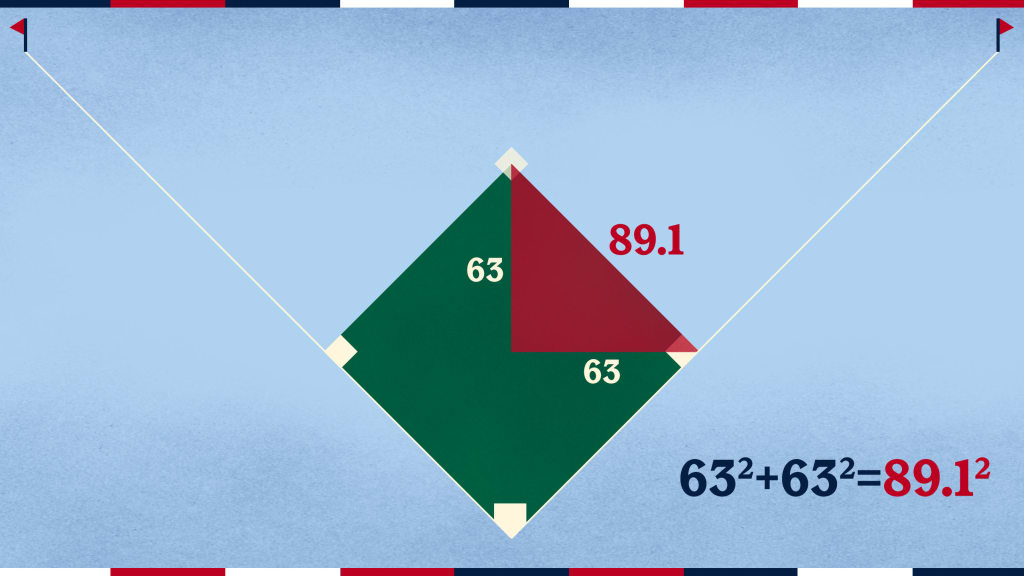
As Major League Baseball embarks upon a season in which the size of the bases has been increased, we regret to inform you that the distance in between bases will not be 90 feet this year.
Yes, that’s a lot to process. We get it. You were born into a world in which the grass is green, the sky is blue and the distance between bases is 90 feet. That’s sacred baseball math, and we understand if you’re upset that these brand-new bags have messed with it.
But wait. Before you get too hot and bothered about the bigger bases, we’ve got another piece of news for you:
The distance between bases was never 90 feet.
How can this be, you ask?
Look, everything you’re about to read is not common knowledge, even within the sport. The truth is, most of us had no idea the bases were 15 inches on each side before MLB expanded them to 18 inches. Even fewer of us understood the intricate nuances of how the distances down the lines and around the infield are measured.
But after researching the topic, we’re here to tell you: It’s a trip. And not a simple 90-foot one.
Now, before we bring out the measuring tape, let’s first discuss how this 90-foot thing came about in the first place. Much like the story of how we got to 60 feet and 6 inches from the pitcher’s mound to the back tip of home plate (emphasis on back tip, because a lot of people don’t know that, either), it’s complicated stuff. As 1800s baseball tends to be.
The Knickerbocker rules -- the earliest surviving rules of baseball -- were codified in 1845. They called for “42 paces” between home and second base and between first and third bases.
OK, so… What, exactly, is a “pace?”
Depends who you ask.
Some scholars have presumed a pace of three feet and come to the conclusion that the ensuing distance between bases would be about 89 feet -- quite close to the 90 feet we know and love. (The math here is a bit tricky for those of us who are not currently taking high school geometry, and the short version is as follows: If we assume 42 paces, at 3 feet per pace, in a straight line from home to second and first to third, that equals 126 feet. Which means it’s 63 feet from the center of the diamond in each direction to all four bases. Now you’ve created four right triangles, each of which has two sides that are 63 feet. Using the Pythagorean Theorem, we can figure out that the hypotenuse is 89.1 feet.)

This is a clean and (nearly) uncomplicated explanation that paints Alexander Cartwright – the man often credited with developing the Knickerbocker rules -- in a particularly positive light. Heck, it’s right there on Cartwright’s Hall of Fame plaque: “Set bases 90 feet apart.”
But wait! Don’t rush to the assumption that what’s captured in Cooperstown is correct in perpetuity.
Pace yourself.
As official MLB historian John Thorn points out, the definition of “pace” in Noah Webster’s “An American Dictionary of the English Language” at the time was as follows:
- A step.
- The space between the two feet in walking, estimated at two feet and a half. But the geometrical pace is five feet, or the whole space passed over by the same foot from one step to another.
If a single pace was known at the time to be 2.5 feet, then that means the distance between each base would then be only 74.25 feet. (Following the same math in the graphic above, in this scenario it is 105 feet from home to second and first to third, which means 52.5 feet from the center of the diamond in each direction to all four bases. And if you use the Pythagorean Theorem again, we see that 52.5 squared plus 52.5 squared equals … 74.25 squared.)
Thorn’s research indicates that 75-foot basepaths were the norm well into the mid-1850s. Then something happened. A fundamental evolution that essentially ushered in the game as we know it.
Baseball became hardball.
“When the ball was wound tighter, gaining more hardness and resilience,” writes Thorn, “it could be hit farther and, crucially, thrown farther.”
This allowed the dimensions of the field to expand.
Daniel Lucius “Doc” Adams, another influential member of the Knickerbockers, claimed that it was he who set the 90-foot standard in the 1850s.
“I was chairman of the Committee on Rules and Regulations from the start and so long as I retained membership,” Adams wrote in 1896. “I presented the first draft of rules, prepared after much careful study of the matter, and it was in the main adopted. The distance between bases I fixed at 30 yards [or 90 feet], the only previous determination of distance being ‘the bases shall be from home to second base 42 paces, from first to third base 42 paces equidistant,’ which was rather vague.”
If we can assume that Adams is telling the truth (again, who knows?), then there’s our answer as to the “how,” albeit not really the “why.” That’ll have to be enough.
We’re still not out of the woods when it comes to complication, though. Because in those formative years of professional baseball, there were various relocations of home plate and changes to the positioning of first and third base, thereby altering the dimensions between bases.
From 1845-74, home plate, then known as “home base” (and that’s a whole other story), was partially in both fair and foul territory. In 1875 and 1876, it was moved entirely to foul territory. Then, in 1877, it was moved entirely to fair territory, where it remains (though it did not get its present-day pentagonal shape until 1900).
First and third base, meanwhile, were initially half in fair territory and half in foul. It was not until 1887 that they were shifted 7 1/2 inches to be placed completely in fair ground.
The effect of all this movement is that the distance between the bases was adjusted multiple times.
What has been a constant -- at the very least, since Doc Adams came along -- is that there has always been a measurement of 90 feet from… somewhere to… somewhere.
From the mid-1850s until the mid-1880s, the 90-foot measurement went from the center of one base to the center of another (this included “home base,” which was initially shaped like a circle and then, like the other bases, a square).
When the aforementioned shift of first and third bases in 1887 occurred, this changed the way 90 feet was measured. Now, it was from the center of home base to the back corner of first and third base. And from the back corner of both first and third to the center of second base. Previously, it was 7 1/2 inches from the edge of a base to its center, meaning that the actual distance in-between bases was reduced by 7 1/2 inches with this change.
Finally, in 1900, when home plate became a pentagon neatly nestled into the shape of the diamond, the method of measurement from home to first and third shifted once again -- from the back tip of home plate to the rear corner of the bases.
That’s how it has remained ever since.
Even now, with the bigger bases.
Though the new bases themselves have been expanded three inches on each side, they do not affect this 90-foot measurement, because the positioning of the bases has not changed and the size of home plate has not changed. All of the extra size of the bases pushes inward.
Let’s lay this out as clearly as we can:
HOME TO FIRST AND HOME TO THIRD
Old 15-inch bases: 87 feet, 3 inches
New 18-inch bases: 87 feet
Difference: 3 inches
In both cases: It is 90 feet from the bottom tip of home plate to the back corners of first and third base.
FIRST TO SECOND AND SECOND TO THIRD
Old 15-inch bases: 88 feet, 1.5 inches
New 18-inch bases: 87 feet, 9 inches
Difference: 4.5 inches
In both cases: It is 90 feet from the back corner of first and third base to the center of second base.
So, there you have it. Hopefully, now you understand that the distance between the bases was never actually 90 feet. We were all living a lie.
(By the way, the 90-foot concern is not the only myth related to the new bases, which fulfilled their purpose in the Minor League trial by reducing injuries around the bases by 13%. Some have suggested that all bang-bang plays at first will now go to the runner because he is three inches closer to the bag. What that argument doesn’t account for is that the first baseman is now three inches closer to the throw. So it’s basically a wash.)
Anyway, if you don’t mind using a loose definition of “between” (just like some scholars have apparently employed a loose definition of “pace”), then, by all means, continue to say that it is 90 feet between bases. Because it’s no less true than it was prior to the arrival of the bigger bases. And it still sounds good.
